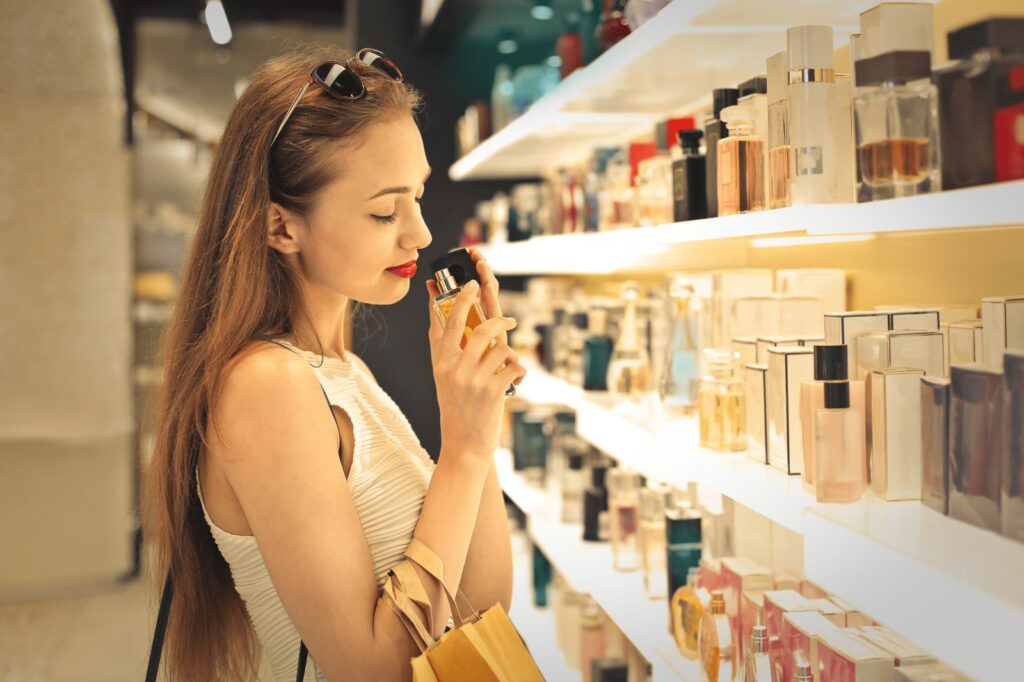Picture source: Neom Organics Scent Discovery
Each time a customer breathes in a marketplace, a marketer has an opportunity to pitch the products that capture the olfactory senses, and interestingly the olfactory senses are directly connected to the emotional centers of our brain. An age-old practice by retailers, traders, hoteliers or any business houses using scent or aromas to influence the consumer behaviour. Research says that 75 percent of our emotions that we feel everyday are due to what we smell. We are 100 times more likely to remember something we smell over something we see, hear or touch.
Based upon our cognitive experiences in the past, fragrances can transport an individual to a different world or to a nostalgic world. Brands like LV uses its signature fragrances in its flagship store. It is believed that stores that smell right, customers tend to stay longer and buy more. Lufthansa airlines of Germany uses mixed aroma of honey, vanilla, hot bread, and breast milk that make its passengers forget their sense of discomfort and make them feel like home. Quite similarly, Singapore airlines, British airlines do use different signature fragrances to make their customers at ease and register a nostalgic experience each time they travel. Hugo Boss has a musky aroma with a touch of citrus in their stores.
The practice of using scent in commercial establishments, not only enhances the brand perception but also create memorable experiences that are long lasting for the customers. Fragrances that are pleasant and relevant to different commercial settings such as retail stores, hotels, spas or any other businesses evoke specific emotions and associations thereby enhancing customer experience and increasing sales. Neuroscience of scent marketing is often integrated into aroma marketing to understand how scent affect the brain and elicit specific consumer behaviour
Smell Sells
The Mechanism of smell: The olfactory system is directly connected to the limbic system and the hippocampus, the limbic system being the seat of human emotions and the hippocampus, the memory centre of the brain. The olfactory bulbs, part of our limbic system, are directly connected to the structures that process emotions, the amygdala and hippocampus for associative learning.
Picture source: Olivia’s Haven
Aroma marketing: Scent marketing in the food industry is very popularly explored by the marketers. Scent marketing is particularly effective because our sense of smell is closely linked to our appetite. When we smell something delicious our mouth starts to water, and we become hungry. Restaurants and fast-food chains have long understood the power of scent marketing and they use it to create an experience that entices customers to purchase more.
The design of the store coupled with the right scents/smell of the store, elicits consumer decision-making based upon strong perceptions about the store as the smell is directly rooted in the emotional seat of the brain – the reward centre of the brain called as nucleus accumbens (NAc).
Expensive or premium leather shoe shops carefully design and infuse tiny amounts of leather smell in the store to make the consumers feel the genuine or high quality of the leather. Similarly, supermarkets selling fruits infuse citrus sprays to elicit purchase behavior, and bakeries infuse the smell of freshly baked bread so that customers jump into the store to buy the baked products.
Fragrances stimulating specific mood:
Researchers found that lavender and rosemary may decrease the stress hormone cortisol. The use of scents such as vanilla, cinnamon and lavender can create a warm and inviting atmosphere that makes customers feel relaxed and comfortable. On the other hand, the use of scents such as citrus and mint can create a fresher and invigorating atmosphere that makes customers feel energised and refreshed. Restaurants also use scent marketing to create a signature and scent that is associated with their brand, this can help to create a sense of familiarity and loyalty among customers. The use of aroma marketing in fast food restaurants is to create a unique and memorable experience for their customers. The use of scents, such as popcorn, chocolate and fried chicken can create a warm and inviting atmosphere that makes customers feel comfortable at home.
“Perfume is the art that makes memory speak.” – Francis Kurkdjian
References & further readings:
- Donovan, Robert J. and John R. Rossiter (1982), “Store Atmosphere: An Environmental Psychology Approach,” Journal of Retailing, 58 (Spring), 34-57.
- Gazzaniga Michael, Ivry Richard B., Mangun George R. Chapter 3. “Methods of Cognitive Neuroscience” of the book “Cognitive Neuroscience: The Biology of the Mind” (2013)
- Martin Lindstrom, Broad sensory branding, Journal of Product & Brand Management, Volume 14, Number 2, 2005, p. 84–87
- Zaltman, Gerald (2003), How Customers Think: Essential Insights Into the Mind of the Market, Cambridge, MA: Harvard Business Press.
- Avery Gilbert (2015). What the Nose Knows: The Science of Scent in Everyday Life, Createspace Independent Pub, ISBN: 1505442877
- Krishna, A. (2012). An integrative review of sensory marketing: Engaging the senses to affect perception, judgment and behavior. Journal of Consumer Psychology, 22(3), 332-351.
- Morrin, M., & Ratneshwar, S. (2003). Does it make sense to use scents to enhance brand memory? Journal of Marketing Research, 40(1), 10-25.
- Spangenberg, E. R., Crowley, A. E., & Henderson, P. W. (1996). Improving the store environment: Do olfactory cues affect evaluations and behaviors? Journal of Marketing, 60(2), 67-80
